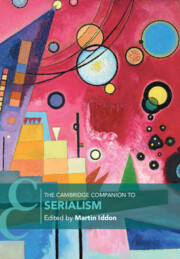Book contents
- The Cambridge Companion to Serialism
- Cambridge Companions to Music
- The Cambridge Companion to Serialism
- Copyright page
- Contents
- Figures
- Tables
- Contributors
- Preface
- Part I Contexts I
- Part II Composers
- 4 Arnold Schoenberg and the ‘Musical Idea’
- 5 Alban Berg’s Eclectic Serialism
- 6 Rethinking Late Webern
- 7 Milton Babbitt and ‘Total’ Serialism
- 8 Pierre Boulez and the Redefinition of Serialism
- 9 The Serial Music of Karlheinz Stockhausen
- 10 Luigi Nono and the Development of Serial Technique
- 11 Stravinsky’s Path to Serialism
- Part III Geographies
- Part IV Contexts II
- References
- Index
9 - The Serial Music of Karlheinz Stockhausen
from Part II - Composers
Published online by Cambridge University Press: 07 March 2023
- The Cambridge Companion to Serialism
- Cambridge Companions to Music
- The Cambridge Companion to Serialism
- Copyright page
- Contents
- Figures
- Tables
- Contributors
- Preface
- Part I Contexts I
- Part II Composers
- 4 Arnold Schoenberg and the ‘Musical Idea’
- 5 Alban Berg’s Eclectic Serialism
- 6 Rethinking Late Webern
- 7 Milton Babbitt and ‘Total’ Serialism
- 8 Pierre Boulez and the Redefinition of Serialism
- 9 The Serial Music of Karlheinz Stockhausen
- 10 Luigi Nono and the Development of Serial Technique
- 11 Stravinsky’s Path to Serialism
- Part III Geographies
- Part IV Contexts II
- References
- Index
Summary
Karlheinz Stockhausen was one of the most important representatives of so-called multiple serial music after 1950. In 1951, he was one of the first European composers to write a musical work, Kreuzspiel, in which all sound parameters are comprehensively shaped with the help of serial procedures. For Stockhausen, serial thinking was rooted in the twelve-tone music of Anton Webern. However, he understood serial thinking not only as a compositional principle, but as a complex mental attitude. On the basis of central stations of Stockhausen's musical oeuvre, the fundamentals, characteristics, and transformations of his serial way of creating are shown. Chronologically, an arc is spanned from the strictly serial works of the early 1950s (his point music) through the statistical, aleatoric, variable, moment, and intuitive music of the late 1950s and 1960s to the formula and multi-formula composition that was at the centre from the 1970s on. The arc closes with a look at the last two major work cycles, Licht(1977–2003) and Klang (2004–7).
Keywords
- Type
- Chapter
- Information
- The Cambridge Companion to Serialism , pp. 140 - 153Publisher: Cambridge University PressPrint publication year: 2023

